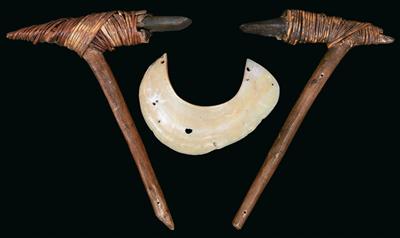Mixed lot (3 pieces), New Guinea: a so-called ‘kina shell’ (jewellery and wealth object) and two stone axes.
Mixed lot (3 pieces), New Guinea: a so-called ‘kina shell’ (jewellery and wealth object) and two stone axes.

1: In the highlands of New Guinea (the Mount Hagen region) shell discs such as this are worn as jewellery, and also represent wealth, exchanged between Papua clans during bride price negotiations or other ceremonial transactions (used like money). These items are called ‘kina shells’. The shells of pearl mussels (or pearl oysters) from the coastal regions of New Guinea are traded far inland for this purpose. There, they are polished into the desired shape, pierced so they can be worn, and decorated. Normally, these shell discs are stored in their own pouches made of bark or leaves. The present kina shell is very old. This is visible on the ‘gently’ worn carrying holes to the left and right at the top. There are decorative dotted lines around the neckline. A good, old piece, with only small damage (a hole to the middle surface and minor pieces broken off at the edges).
Height: c. 17 cm; width: 23 cm. About 1900 or earlier.
Note: the modern currency of the country of Papua New Guinea is also called ‘Kina’ after these kina shells.
2: Two old stone axes from New Guinea. Each with a smooth polished stone blade: one blade is made of black stone, the other of dark greyish green stone. Both stone blades are in knee-shaft hafting, fixed into their wooden hilts with wooden wedges, black tree resin and a firm, decorative rattan binding. All the visible wooden parts of both stone axes have a good patina as a result of protracted use. There are small pieces broken off from the stone blades, which imply that these interesting tools were used over a long period of time.
The three holes drilled through the wooden shafts are secondary and were made by their owner at the time, who displayed the objects on the wall of his house. Length: 39 cm and 40 cm; width: 25 cm and 30 cm (the transversal parts with blades).
Both stone axes: first half of the 20th century or earlier. (ME)
Provenance: Private collection of an Austrian traveller.
Esperto: Prof. Erwin Melchardt
 Prof. Erwin Melchardt
Prof. Erwin Melchardt
+43-1-515 60-465
erwin.melchardt@dorotheum.at
06.04.2017 - 15:00
- Prezzo di partenza:
-
EUR 500,-
Mixed lot (3 pieces), New Guinea: a so-called ‘kina shell’ (jewellery and wealth object) and two stone axes.
1: In the highlands of New Guinea (the Mount Hagen region) shell discs such as this are worn as jewellery, and also represent wealth, exchanged between Papua clans during bride price negotiations or other ceremonial transactions (used like money). These items are called ‘kina shells’. The shells of pearl mussels (or pearl oysters) from the coastal regions of New Guinea are traded far inland for this purpose. There, they are polished into the desired shape, pierced so they can be worn, and decorated. Normally, these shell discs are stored in their own pouches made of bark or leaves. The present kina shell is very old. This is visible on the ‘gently’ worn carrying holes to the left and right at the top. There are decorative dotted lines around the neckline. A good, old piece, with only small damage (a hole to the middle surface and minor pieces broken off at the edges).
Height: c. 17 cm; width: 23 cm. About 1900 or earlier.
Note: the modern currency of the country of Papua New Guinea is also called ‘Kina’ after these kina shells.
2: Two old stone axes from New Guinea. Each with a smooth polished stone blade: one blade is made of black stone, the other of dark greyish green stone. Both stone blades are in knee-shaft hafting, fixed into their wooden hilts with wooden wedges, black tree resin and a firm, decorative rattan binding. All the visible wooden parts of both stone axes have a good patina as a result of protracted use. There are small pieces broken off from the stone blades, which imply that these interesting tools were used over a long period of time.
The three holes drilled through the wooden shafts are secondary and were made by their owner at the time, who displayed the objects on the wall of his house. Length: 39 cm and 40 cm; width: 25 cm and 30 cm (the transversal parts with blades).
Both stone axes: first half of the 20th century or earlier. (ME)
Provenance: Private collection of an Austrian traveller.
Esperto: Prof. Erwin Melchardt
 Prof. Erwin Melchardt
Prof. Erwin Melchardt
+43-1-515 60-465
erwin.melchardt@dorotheum.at
|
Hotline dell'acquirente
lun-ven: 10.00 - 17.00
kundendienst@dorotheum.at +43 1 515 60 200 |
| Asta: | Tribal Art |
| Tipo d'asta: | Asta in sala |
| Data: | 06.04.2017 - 15:00 |
| Luogo dell'asta: | Wien | Palais Dorotheum |
| Esposizione: | 01.04. - 06.04.2017 |
